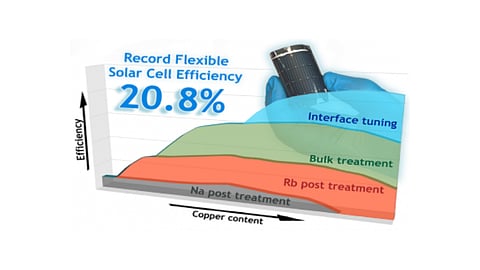

The Swiss Federal Laboratories for Materials Testing and Research (Empa) has reported achieving 20.8% conversion efficiency for copper indium gallium diselenide (CIGS) solar cells on flexible polymer substrate. With this, Empa says, it has broken its own mark by reaching 0.4% points higher efficiency.
The cells were produced by The Empa Laboratory for Thin Films and Photovoltaics and the findings have been published in the special issue 'Excellence in Energy' of the journal 'Advanced Energy Materials'.
CIGS thin-film technology enables manufacturing of flexible, lightweight solar cells on polymer films. For their research, Empa's team adjusted the chemical composition of the absorber layer to improve its electronic and optical properties. Another change it incorporated was to develop new methods for alkali metal doping, and adapting the properties of the absorber-buffer interface to improve cell performance.
These 3 major improvements helped reach the efficiency record, said Romain Carron, head of CIGS Research at Empa's laboratory.
Flexible CIGS solar modules are already commercially available, among others from the Empa spin-off Flisom, which was co-founded by Empa thin films and PV lab head Ayodhya N. Tiwari, stated Empa. "Such high efficiency as we have now achieved in our laboratory demonstrates the potential of the technology. Future developments will be aimed in particular at transferring our new process from laboratory to industrial scale in order to increase the power generation and profitability of photovoltaic systems," added Tiwari.
The world record efficiency for a CIGS lab cell is 22.9% and is being held by Solar Frontier from Japan since Nov. 2017.
.png?w=50&fm=png)